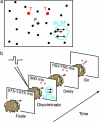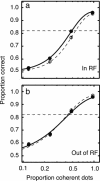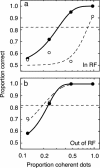Microstimulation of the superior colliculus focuses attention without moving the eyes
- PMID: 15601760
- PMCID: PMC545556
- DOI: 10.1073/pnas.0408311101
Microstimulation of the superior colliculus focuses attention without moving the eyes
Abstract
The superior colliculus (SC) is part of a network of brain areas that directs saccadic eye movements, overtly shifting both gaze and attention from position to position, in space. Here, we seek direct evidence that the SC also contributes to the control of covert spatial attention, a process that focuses attention on a region of space different from the point of gaze. While requiring monkeys to keep their gaze fixed, we tested whether microstimulation of a specific location in the SC spatial map would enhance visual performance at the corresponding region of space, a diagnostic measure of covert attention. We find that microstimulation improves performance in a spatially selective manner: thresholds decrease at the location in visual space represented by the stimulated SC site, but not at a control location in the opposite hemifield. Our data provide direct evidence that the SC contributes to the control of covert spatial attention.
Figures





Comment in
-
Biography of William T. Newsome.Proc Natl Acad Sci U S A. 2005 Jan 18;102(3):521-3. doi: 10.1073/pnas.0409116102. Epub 2005 Jan 12. Proc Natl Acad Sci U S A. 2005. PMID: 15647353 Free PMC article. No abstract available.
References
-
- Ferrier, D. (1890) Cerebral Localisation (Smith, Elder and Co., London).
-
- Rizzolatti, G., Riggio, L., Dascola, I. & Umilta, C. (1987) Neuropsychologia 25, 31-40. - PubMed
-
- Kowler, E., Anderson, E., Dosher, B. & Blaser, E. (1995) Vision Res. 35, 1897-1916. - PubMed
-
- Sperling, G. & Melchner, M. J. (1978) Science 202, 315-318. - PubMed
-
- Hoffman, J. E. & Subramaniam, B. (1995) Percept. Psychophys. 57, 787-795. - PubMed
Publication types
MeSH terms
Grants and funding
LinkOut - more resources
Full Text Sources
Other Literature Sources

